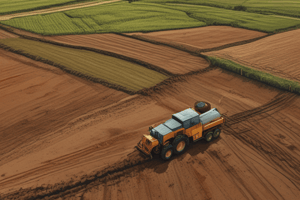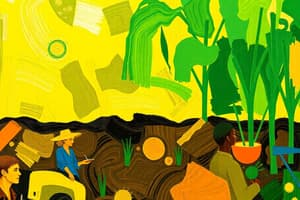Podcast
Questions and Answers
What is the definition of agriculture?
What is the definition of agriculture?
Agriculture is the science that deals with the raising of plants and rearing of animals for human use.
How did the domestication of plants and animals change human lifestyle?
How did the domestication of plants and animals change human lifestyle?
It allowed humans to settle down in communities, reducing the need to wander in search of food.
What is meant by crop farming?
What is meant by crop farming?
Crop farming refers to the growing and harvesting of crops.
Describe the role of irrigation in modern agriculture.
Describe the role of irrigation in modern agriculture.
What agricultural tools were developed to assist in farming?
What agricultural tools were developed to assist in farming?
Explain the difference between horticulture and crop farming.
Explain the difference between horticulture and crop farming.
Why is soil management important in agriculture?
Why is soil management important in agriculture?
What advancements in machinery have contributed to modern agriculture?
What advancements in machinery have contributed to modern agriculture?
What is the effect of dry and excess water on seed germination?
What is the effect of dry and excess water on seed germination?
Why is it important to plant seeds at the correct distance from each other?
Why is it important to plant seeds at the correct distance from each other?
What are the advantages of using seed drills over broadcasting?
What are the advantages of using seed drills over broadcasting?
Explain the process of transplantation in agriculture.
Explain the process of transplantation in agriculture.
What are macronutrients and why are they important for plants?
What are macronutrients and why are they important for plants?
Describe the role of micronutrients in plant growth.
Describe the role of micronutrients in plant growth.
What is the purpose of fallowing in soil nutrient management?
What is the purpose of fallowing in soil nutrient management?
How does crop rotation help in maintaining soil nutrients?
How does crop rotation help in maintaining soil nutrients?
What are the three main types of pesticides mentioned, and what does each target?
What are the three main types of pesticides mentioned, and what does each target?
List two advantages and two disadvantages of using chemical control methods for pests.
List two advantages and two disadvantages of using chemical control methods for pests.
Explain how biological control differs from chemical control in pest management.
Explain how biological control differs from chemical control in pest management.
What process is described as the cutting and gathering of mature crops from fields?
What process is described as the cutting and gathering of mature crops from fields?
What is threshing, and how is it commonly performed?
What is threshing, and how is it commonly performed?
Identify one method for harvesting fruits and vegetables on small farms.
Identify one method for harvesting fruits and vegetables on small farms.
What role does cold storage play after harvesting crops?
What role does cold storage play after harvesting crops?
What are some potential negative effects of pesticides on the environment?
What are some potential negative effects of pesticides on the environment?
What is crop rotation and why is it practiced?
What is crop rotation and why is it practiced?
Describe multiple cropping and its benefits.
Describe multiple cropping and its benefits.
What are the two main methods of increasing soil fertility mentioned?
What are the two main methods of increasing soil fertility mentioned?
What are manures and how do they affect soil fertility?
What are manures and how do they affect soil fertility?
Explain the process of making compost.
Explain the process of making compost.
What are chemical fertilizers and how do they differ from organic manures?
What are chemical fertilizers and how do they differ from organic manures?
List the main nutrients that chemical fertilizers supply.
List the main nutrients that chemical fertilizers supply.
What is the risk associated with the application of chemical fertilizers?
What is the risk associated with the application of chemical fertilizers?
What is the primary method used for threshing in developed areas?
What is the primary method used for threshing in developed areas?
How does wind winnowing separate grain from chaff?
How does wind winnowing separate grain from chaff?
What is the significance of proper food storage after crop yield?
What is the significance of proper food storage after crop yield?
Describe the role of grain silos in food storage.
Describe the role of grain silos in food storage.
What is buffer stock and why is it maintained?
What is buffer stock and why is it maintained?
What is animal husbandry and its economic role?
What is animal husbandry and its economic role?
List some ways in which animals benefit humans.
List some ways in which animals benefit humans.
Explain the importance of livestock as draught animals.
Explain the importance of livestock as draught animals.
Study Notes
Agriculture
- Agriculture is the science of raising plants and animals for human use.
- It involves soil management, crop farming, horticulture, and animal husbandry.
- Humans started agriculture around 10,000 years ago, initially growing wheat and barley.
- This led to a change in human lifestyle, allowing people to settle down in communities and domesticate animals.
- Modern agriculture focuses on improving crop quality and yield.
- Different crops require specific soil types and water needs, like rice in clayey soil with abundant water and wheat in alluvial soil with less water.
- Irrigation techniques, like dam and canal construction, have been developed to provide water to crops.
- Tools like sickles, axes, and ploughs, and machinery like tractors, combine harvesters, and threshers, have improved farm efficiency and increased output.
Crop Growth
- Seeds need the right amount of water to germinate, not too dry or too wet.
- Seeds should be planted at appropriate distances for optimal sunlight, water, and nutrient access.
- Broadcasting scatters seeds manually over the soil surface.
- Seed drills deposit seeds at regular intervals using a funnel and long tubes attached to a plough, ensuring more accurate sowing than broadcasting.
- Transplantation involves growing seeds in a nursery and then transferring seedlings to the field, allowing for selection of healthy seedlings and proper spacing for increased crop yield.
Plant Nutrients
- Plants require 16 nutrients for proper growth, categorized into macronutrients and micronutrients.
- Macronutrients are needed in large quantities, including carbon, hydrogen, oxygen, nitrogen, phosphorus, potassium, calcium, magnesium, and sulfur.
- Micronutrients are needed in smaller quantities, including iron, manganese, copper, boron, molybdenum, zinc, and chlorine.
- Carbon is obtained from atmospheric carbon dioxide, oxygen from air and water, and hydrogen from water.
- Other nutrients are absorbed from the soil.
Soil Fertility Management
- Long-term cultivation depletes soil nutrients.
- Fallowing, leaving land uncultivated for a season, is an old method of replenishing nutrients but is less common with increasing population and food demands.
- Crop rotation involves alternating crops to prevent depletion of specific nutrients. For example, legumes fix nitrogen and replenish the soil, preparing it for subsequent wheat or rice crops.
- Multiple cropping grows two or more crops together in the same field, utilizing product and waste interactions to improve soil fertility and yield, like cotton and groundnut.
Manures and Fertilizers
- Manures, organic matter composed of dead plants and animal waste, are rich in soil-building material and release nutrients slowly, providing long-lasting benefits.
- Compost is manure made by decomposing plant and animal waste, usually safe to apply directly to soil.
- Chemical fertilizers, containing inorganic salts, supply mainly nitrogen, phosphorus, and potassium, providing quick nutrient boosts but with a shorter impact compared to manures.
Pest and Disease Control
- Pesticides, chemical substances that kill pests, are classified into insecticides (for insects), fungicides (for fungi), and rodenticides (for rodents).
- Chemical control involves spraying pesticides, while biological control uses one organism to regulate the population of pests.
- Chemical control has advantages like fast pest killing and ease of use, but disadvantages include pest resistance, potential harm to wildlife, environmental pollution, and risks to human health.
- Biological control offers an alternative approach but may also have unintended consequences for native species.
Harvesting and Storage
- Harvesting involves cutting and gathering mature crops from fields.
- Fruits and vegetables can be harvested manually or mechanically and sold immediately or stored for future use.
- Grains are harvested manually with sickles in small farms or with combine harvesters in large farms.
- Threshing separates the edible part of grain from chaff, done manually or with a combine harvester.
- Winnowing removes chaff and insects from harvested grain by throwing the mixture into the air, allowing lighter chaff to blow away while heavier grains fall down.
Storage
- Grains are dried in the sun and packed into bags or bins for storage in granaries.
- Grain silos are specially designed containers for bulk storage, with controlled temperature for inspection, fumigation, and pest protection.
- Buffer stock is a reserve of grain to compensate for shortages caused by adverse weather conditions.
Animal Husbandry
- Animal husbandry involves breeding, feeding, and caring for livestock for food and other purposes.
- Livestock provides milk, meat, eggs, hides, and draught animals (for plowing and carrying loads).
- Domestication of animals began around 10,000 BCE when humans started settling down.
- Animals are essential for various needs, providing food, clothing, transportation, and companionship.
Studying That Suits You
Use AI to generate personalized quizzes and flashcards to suit your learning preferences.
Related Documents
Description
This quiz covers the fundamentals of agriculture, including the science behind raising plants and animals for human use. It discusses soil management, irrigation techniques, and the tools used in modern farming. Additionally, the quiz delves into the essential conditions for seed germination and crop growth.




